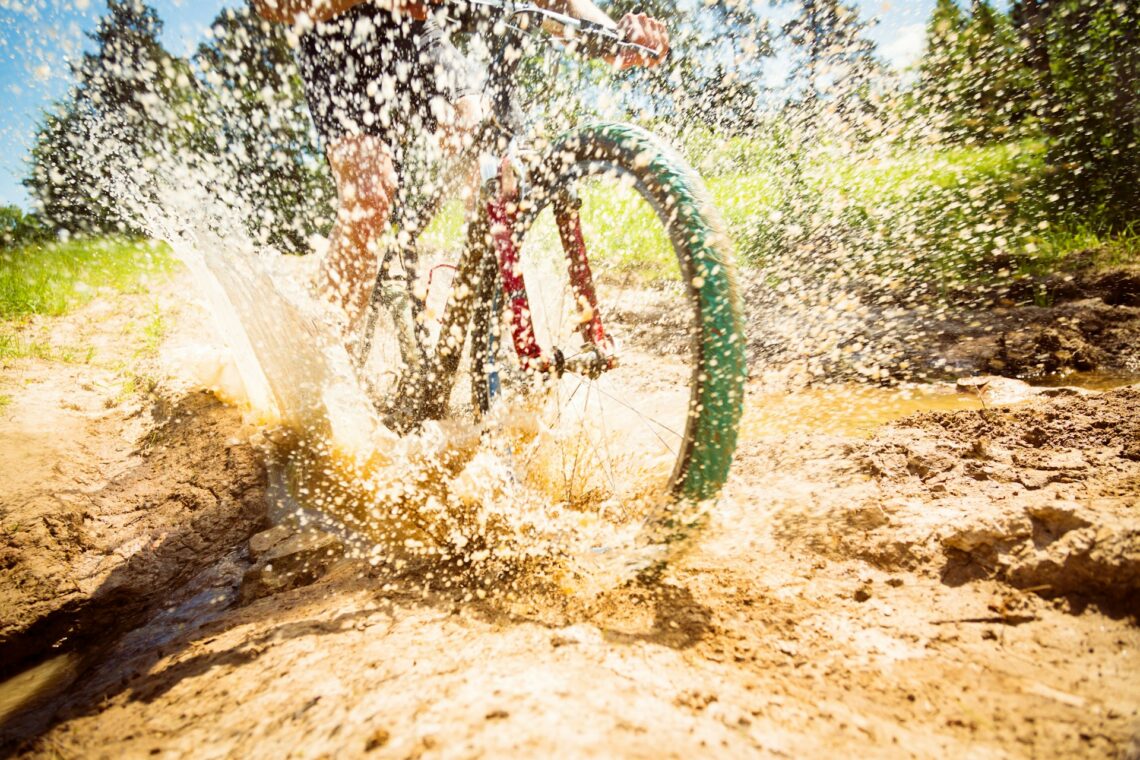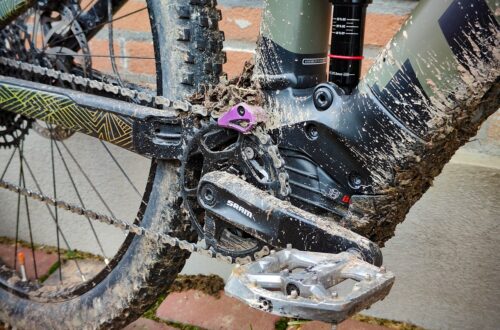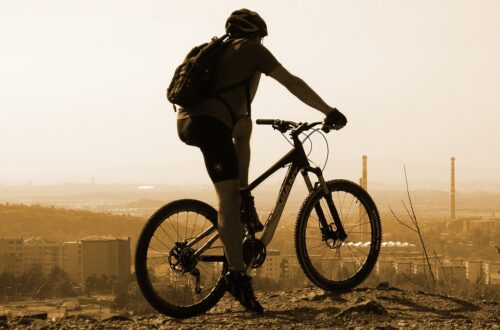
Can An Electric Mountain Bike Get Wet?
The purpose of a mountain bike is to be able to cycle off-road. Getting in contact with mud and water is inevitable. Although your mountain bike and its components don’t particularly like it, they’re designed to cope with it. But is that the same for an e-bike? Can an electric mountain bike get wet?
An electric mountain bike can get wet since the electrical components are water resistant. To which extend is determined by the IP-rating. The most common e-mtbs are at least resistant to water splashes. Consult the manufacturer to find out exactly how water resistant the control unit, battery and motor is.
As we all know, water and electricity don’t mix. We can assume that the manufacturers of e-bikes know this and have come up with a way of keeping water out of vital areas. But how wet can they get before a short circuit occurs? Are there ways to prevent water damage on your expensive electric mountain bike?
Delicate Components Of An Electric Mountain Bike
Apart of a few added components, the basics of an electric mountain bike are no different from a regular mountain bike. This means that there are a few (a lot to be honest) components that don’t like water. But when they are maintained properly, it isn’t a problem. This applies to the drive train (chain ring, chain and cassette), headset, bottom bracket, wheel bearings, pedal bearings, freehub, suspension (front and back), and pivot points (especially for full suspension). A thorough clean and lubrication after a ride in the wet prevents them from getting damaged.
The added (electrical) components that are much more sensitive to water ingress, are the control unit (display on your handlebar), battery and motor. To connect all of these and make them work together, there are connectors, terminals and wires. Water ingress to these delicate components may result in a short circuit.
What Do The Manufacturers Say About Water And E-Bikes?
To keep you riding and prevent short circuits in one of the aforementioned electrical parts, manufacturers gaskets and seals to keep the water out. It’s important to mention that there is a difference between something being waterproof and water resistant. Waterproof means that there is no way water can ingress; water resistant means that something is able to resist water up to a certain degree. Why this difference is important, we’ll get to later. What do well-known manufacturers of the electrical components say about getting in contact with water?
IP-Rating
The IP-rating (Ingress Protection) is a code which indicates how well an electrical device is protected against dust or liquids. This makes it easier for designers to source components which match the requirements of the product, and to inform end users about to which extend they can expose the product to the elements. The IP-rating can be determined by the manufacturers themselves by performing test according to set guidelines and standards. There are also third-party independent testing agencies who can perform the tests.
The IP-rating or code consists of the letters ‘IP’ followed by two numbers. The first number is about protection against dust and goes from 0 to 6; the second number is about protection against liquids and goes from 0 to 9. It means that the higher the rating in each category, the better the component is protected against dust and liquid ingress. IP 69 would be the highest rate of protection.
When it comes to a battery, motor or control unit of an electric mountain bike, you should look at the IP-rating before crossing a shallow river. Replacing a motor or battery is very expensive.
IP-Rating Of Well-Known Brands
The most used engine and battery brands are Bosch, Brose, Fazua, Shimano and Yamaha. The IP-rating of the electrical components of these brands, vary between IP 54 (dust and splash proof) and IP 67 (almost waterproof). A bike with IP 54 components can be ridden in rainy conditions on muddy trails. A bike with IP 67 components means that those components can stay under water with a a maximum depth of 1 meter for a duration of 30 minutes.
Not every brand is as clear about the IP-rating of their components. This is probably due to the the fact that most end users don’t know what an IP-rating is. For most people it is easier to understand instructions. If you are to use your electric mountain bike often in very wet conditions, comparing mountain bikes will definitely pay off in the long rung. Compare bikes and look at how water resistant they are.
The instructions about to what extend you can expose your electric mountain bike to water, can be found in the user manual or on the website of the manufacturer. For the control unit, battery and motor, the advise is always: never clean your electric bike with a high pressure washer. The control unit must be cleaned with a damp cloth and may not be submerged in water. The battery must be stored in a dry, well-ventilated location.
Fully Waterproof Electrical Components
If you look into the IP-rating of e-bike components, you’ll find that none are fully waterproof. The reason for this, is the amount it would cost to make them The motor for example, would become heavier with more drag. This has an effect on the power at the wheel and the range of the bike. As a result of this, the battery should then have a larger capacity which also adds to the weight… You get my point. If a fully waterproof battery and motor would actually exist and water ingress is no longer possible, the manufacturer would sell less replacement batteries and motors.
Tips For Preventing Water Damage On An EMTB
Whilst using your bike in accordance to the instructions of the manufacturer, there are a few things you can do to prevent water damage to your electrical components in the long run. As implied, these tips are an addition to the instructions of the manufacturer. The tips below will not make your bike waterproof in any way and does not create an opportunity to take your electric mountain bike swimming.
- Turn off the power before cleaning. This is not only more safe for your fingers, but also for your bike.
- Remove the guard of your motor regularly. Clean the underside of the motor using soapy water and a soft brush (like a paint brush). If you are technically minded, unplug the connectors, clean them up and use dielectric grease to seal them.
- Protect the control unit whilst cleaning. Wrap a cloth around the control to prevent direct contact with water.
- Spray contact cleaner. Use this on the battery and bike terminals (where the battery connects to the bike). Also, spray it in the charging socket on your frame. This drives out the standing water.
- Don’t use the charging socket on your bike. Remove the bikes battery if possible and charge it in a dry well-ventilated room. This way the terminals on the battery and bike stay dry.
- Ride the bike around the block after washing. This will get rid of standing water in places that are hard to reach when drying.
- Don’t use an air compressor to dry your bike. This has the same effect on the components as a pressure washer.
These tips also apply for regular mountain bikes. The only difference is that mechanical damage as a result of water will only emerge later.
Summary: Can An Electric Mountain Bike Get Wet?
As we’ve seen, electric mountain bikes can get wet and will not create a short circuit as soon as there is contact with water. How wet they can get, differs from brand to brand and is determined by the IP-rating of the component. The higher the number, the better it is protected against dust and liquids. If the IP-rating is not available, the owners manual will tell you to what extend the bike is protected against water ingress. It is definitely not recommended to clean an e-mtb with a pressure washer or completely submerge it in water. This prevents damage to the control unit, motor and battery.
Frequently Asked Questions
Best Mountain Bike For Wet Conditions?
If you use your electric mountain bike often in wet conditions, you should get an electric mountain bike with a TQ motor. It has an IP-rating of 67, which means that the motor can be submerged in water with a depth of 1 meter for a duration of 30 minutes. These motors can be found in some models of Trek, Scott and Stevens.
Can You Clean An E-Bike With A Pressure Washer?
The electrical components on an e-bike like the motor, battery and control unit, are not resistant to being cleaned with a pressure washer. Short circuit might happen due to water ingress. Clean your bike with a garden hose instead and protect your control unit by covering it with a cloth.
Is An E-Bike Waterproof?
An e-bike is not waterproof but water resistant. This means that the components are protected to water ingress up to a certain degree. Fully waterproof electric bikes don’t exist since they would be very expensive to make.
What’s The IP-Rating Of An E-Bike?
Most e-bikes have an IP-rating of around 54. This means that they are very capable of dealing with water splashes from all directions and dust. Direct contact with water from a pressure washer or completely submerging it in water should be avoided at all times.
Can I Leave My E-Bike In The Rain?
An e-bike can be left in the rain and the water will not cause any damage. Advised is to clean (dry) it afterwards and store the battery in a dry, well-ventilated location.





